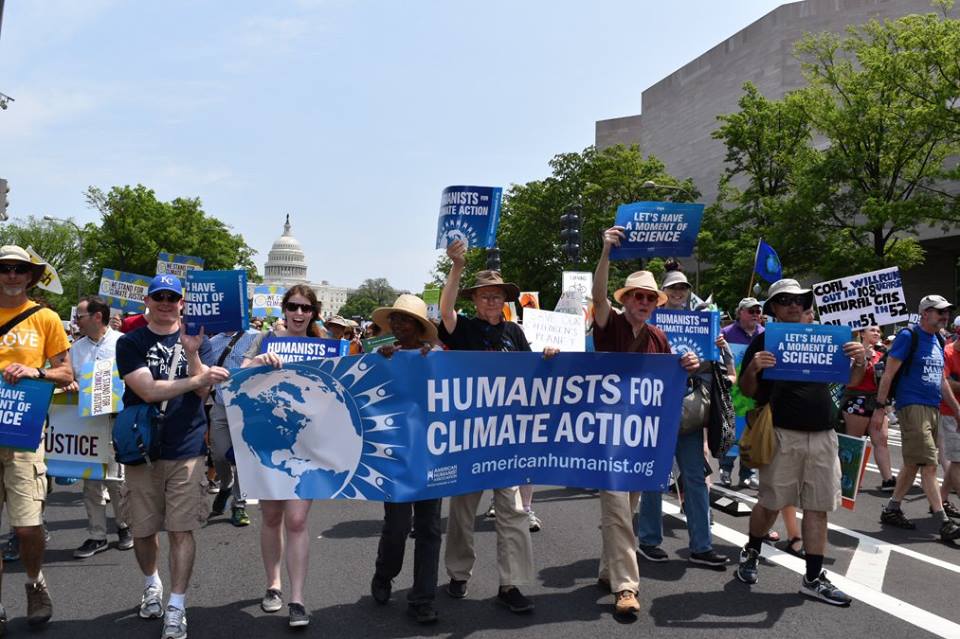Ask What You Can Do for Your Climate

While the federal government is becoming a follower rather than a leader on climate change, we humanists can fight on the state, local, and personal levels to achieve huge reductions in greenhouse gases.
IF THE PERSONAL IS POLITICAL, then climate change is personal, too. As a presidential candidate, Donald Trump campaigned against the Paris Agreement negotiated in December 2015 at the 21st Conference of the Parties of the United Nations Framework Convention on Climate Change. With President Trump signing an executive order to roll back federal efforts to reduce global warming, humanists must do more at the state and local levels to fight climate change. If you’re up for it, there are many things you can do to help.
Greenhouse gases (GHG) are the target, and carbon dioxide is the biggest culprit. The Paris Agreement urges limiting the overall rise in global temperature to 1.5 degrees Celsius. Limiting the rise to that level does not eliminate the chance of great disruption, but even to meet that goal by 2050, we cannot waste time.
We must—and can—reduce our GHG emissions to nearly zero. Even natural gas, despite the ace marketing efforts of the gas industry, must be eliminated from our daily lives. Whole books have been written on the assumption that natural gas could replace dirtier carbon-based fuels. The fact is that an all-out effort is needed to replace methane and all other GHGs with alternatives, especially the carbon-free renewable fuel sources: wind, water, and sunlight. Energy conservation is an important element in more quickly achieving near-zero emissions. This framework defines the policy and personal choices that can make the difference.
State & Local Governmental Policies
 At the state and local level, we must first elect climate-change acknowledgers to office. Then we must badger our legislators, governor, and other elected officials to demand policy changes. At the broadest level, planning documents must be revised to set lower GHG emissions targets. Even the 2017 Scoping Plan that the California Air Resources Board proposed in January seeks only a 40 percent cut in GHG emissions by 2030. That is one of the best state plans, if not the best, but that reduction is still not fast enough.
At the state and local level, we must first elect climate-change acknowledgers to office. Then we must badger our legislators, governor, and other elected officials to demand policy changes. At the broadest level, planning documents must be revised to set lower GHG emissions targets. Even the 2017 Scoping Plan that the California Air Resources Board proposed in January seeks only a 40 percent cut in GHG emissions by 2030. That is one of the best state plans, if not the best, but that reduction is still not fast enough.
We know that a large percentage of fossil-fuel reserves must stay in the ground forever. So forget fracking. States can ban it, like Maryland did in March. We must also push states to defy the president and permanently prohibit all new coal mines and drilling of oil or gas wells of any sort, as well as regulate existing mines and wells and accelerate their shut-down schedules. To mitigate economic consequences, citizens must push state legislatures to appropriate public money for retraining programs and early retirement options for coal miners. Private industry must be prohibited from building electric generating plants that burn carbon-based fuels. Other consumption of GHG-generation processes should be limited to those for which there is no reasonable alternative, such as hydrogen gas.
Lobbying state legislators to pass laws favorable to alternative energy generation, thereby countering energy-industry lobbying, is another essential action for humanists and their allies to take. Particularly, legislation is needed to force public utilities to accept unlimited amounts of electricity privately generated from wind, water, and sunlight and to pay at least a reasonable wholesale price for it. Too many utilities have been getting away with restricting or even refusing it. For example, where I live in Washington, DC, the electric utility only allows customers to produce as much as they use on average over the course of a full year.
With respect to governments themselves, we must demand facilities and equipment be retrofitted and replaced with an eye toward zero-GHG emissions and reduced electrical use, especially heating and cooling costs. Lawmakers can be pressured to pledge, for example, to support outfitting government buildings with rooftop solar panels. Enactment of pertinent purchasing laws can make these policies uniform. Humanists can be instrumental in pushing for these investments. Students and alumni can likewise be a big factor in nudging universities to do these things. University of Virginia alumni, students, faculty, and staff in a group called “Wahoos for Sustainability” have pushed the university hard on sustainability issues, and recently UVA signed a long-term agreement to buy all of the electricity produced by a solar farm that will be built by the regional electric utility.
We can petition state public utility commissions (PUCs) to exercise authority over utilities in their jurisdiction. Querying PUC staff and reading laws specifying their powers will clarify what a given PUC can do. Their authority may include requiring separate ownership of the electrical grid in the state and production facilities, to ensure access to the grid by small producers. PUCs may also have authority to require the upgrading of the grid within their state to utilize the latest smart-grid technologies. They may be able to temporarily or permanently halt issuance of new permits for generating facilities using carbon-based fuels. They may have the power to rescind existing permits for new coal- and oil-burning electric generating facilities and pipelines, and even natural-gas burning facilities, depending on how near the projects are to completion. PUCs may regulate existing gas wells and pipelines to these ends. Given the powerful effect of unburned natural gas, stringent rules for searching for and repairing leaks in natural gas wells and pipelines must be adopted immediately to compensate for the March cancellation of new federal regulations by Trump’s head of the Environmental Protection Agency. Of course, humanists can lobby the state legislature to enact these policies where the PUC in that state lacks authority to do it. In bigger cities, the city council may be able to impose similar requirements on local utilities.
 Certainly, using existing uranium-fueled nuclear generators for their useful lives can help in the interim before renewable energy generation is enough, so long as the safety of those plants is strictly monitored. Given the high cost and carbon footprint of using uranium fission and the danger of radioactive byproducts, the main focus for the new construction of generating facilities should be on those generating from wind, water, and sunlight. The lesser-known thorium-fueled nuclear reactor design could help substitute for carbon fuels. But India has the most advanced national program of building thorium reactors, and its target is only 30 percent of its projected needs by 2050. Politically, the mindset of the federal Energy Department and Nuclear Regulatory Commission soon to be controlled by Trump appointees would have to undergo a sea change for that type of reactor to begin to be built commercially in the United States.
Certainly, using existing uranium-fueled nuclear generators for their useful lives can help in the interim before renewable energy generation is enough, so long as the safety of those plants is strictly monitored. Given the high cost and carbon footprint of using uranium fission and the danger of radioactive byproducts, the main focus for the new construction of generating facilities should be on those generating from wind, water, and sunlight. The lesser-known thorium-fueled nuclear reactor design could help substitute for carbon fuels. But India has the most advanced national program of building thorium reactors, and its target is only 30 percent of its projected needs by 2050. Politically, the mindset of the federal Energy Department and Nuclear Regulatory Commission soon to be controlled by Trump appointees would have to undergo a sea change for that type of reactor to begin to be built commercially in the United States.
Sewer utilities can play an important role in lowering harmful emissions. We’ve all heard of the problem of cow flatulence, but also very damaging is the amount of methane produced in processing human waste. The natural fermentation process makes producing the natural gas from sewerage treatment unavoidable. Sewerage districts can nonetheless capture the resulting natural gas and feed it into the natural gas network. My local utility, DC Water, is now capturing the methane from sewerage treatment, but it is merely burning it for electric generation. We have to fight to require every sewerage district to capture the gas from their sewerage treatment, rather than venting it into the atmosphere. But the long-term solution must be to use the captured gas only for industrial uses for which there is no substitute, rather than generic electricity generation. In that way, it can help reduce the need to pull gas out of the ground for those purposes.
 Local zoning codes enacted by city councils and county boards are instrumental. Where states have not updated the building code, local codes may serve to make those same changes. Require solar panels on all roofs! In addition, building codes can make construction of vehicle charging stations and equipment for generating electricity from wind, water, and especially sunlight easy and low-cost. We have to fight for it.
Local zoning codes enacted by city councils and county boards are instrumental. Where states have not updated the building code, local codes may serve to make those same changes. Require solar panels on all roofs! In addition, building codes can make construction of vehicle charging stations and equipment for generating electricity from wind, water, and especially sunlight easy and low-cost. We have to fight for it.
State and local policy on transportation can have a huge impact on GHG emissions. The obvious steps are raising gasoline and other carbon-fuel taxes and expanding mass transit, bike lanes, and pedestrian-friendly planning in populated areas. Public bus transit will soon be able to move from natural gas-fueled buses to electric ones. Cities can require taxi companies and ride service providers to use hybrid or electric vehicles. All sorts of incentives for electric vehicles and charging stations, and taxes on carbon-fuel burning vehicles, can be applied to speed and ease the changeover to electric. We must advocate for this.
Finally, state governments must be pushed to change building codes to outlaw installation of furnaces, stoves, fireplaces, and water heaters that burn carbon-based fuels in new construction or major building renovations. They could go so far as to prohibit replacement of those items with anything but an electric replacement in existing housing—what a life-affirming step that would be! Let’s demand it.
Personal Acts
Changing local and especially state policies will take some time, but individuals don’t have to wait for those changes to make others on their own. Reducing one’s personal carbon footprint can entail reducing energy consumption as much as replacing carbon-fuel burning equipment. Every cut in use of power incrementally reduces the necessity for power plants that generate electricity from non-renewable sources. The life of an average US citizen contributes more than sixteen metric tons of CO2 into the atmosphere. Each metric ton has been estimated to contribute to the loss of as much as three square meters of sea ice in the Arctic, not to mention glaciers in Antarctica and elsewhere.
You already know that the method of transportation you choose and the distance you go make a huge difference. Diesel-powered trains are of course worse than the electric trains that run, for example, between Boston and New York City. Driving in an electric car is better than a hybrid or gasoline-only car. Even an old-school car full of people is better than an airplane, especially for trips of 300 to 500 miles. Longer trips, well, you can’t get away from emitting as much as a ton of CO2.
You can also reduce electricity use by your electronics. Obviously, making them more efficient isn’t an option for the individual. But they and the networks they depend on have come to consume an amount gaining on 10 percent of electricity worldwide. Besides the obvious expense of buying more efficient models, simply using them less and getting power supplies that aren’t always in stand-by mode are less obvious methods that can save energy. An average email has been estimated to cause emission of four grams of CO2 when powered by carbon-based fuel, but large attachments can ramp that up to fifty grams or more. While LCD-screen TVs use less power than old CRT ones, plasmas in fact are power hogs, consuming three times as much as the CRT models. Gamers consume a lot of electricity. You can choose lower usage consoles or simply unplug when they’re not in use to save a little. Homeowners can refuse to buy so-called smart appliances. Did you know that a microwave oven with a clock display may burn more electricity over its lifetime to display the time than it will actually cooking food?
Due partly to power consumption by Internet servers, streaming an album something like twenty-seven times uses the same amount of electricity as making and shipping a compact disc of the album. But that leaves out the electricity used in playing the disc. Buying the music online and downloading can obviously save a lot in that equation. Data on other comparisons is scarce.
Homeowners have lots of other opportunities. Heating and cooling generate the most GHG of any personal activity, so put solar panels on the roof of your house and garage. Current incentives make them surprisingly inexpensive. To go deluxe, add a whole-house battery to even out your consumption of self-generated power. You can then replace wood, gas, oil, or coal furnaces with electric heat pumps. Even efficient forced hot-water furnaces running on electricity are available now. I’m planning to install one in my house to replace our wasteful eighty-year-old gas furnace. If installing central air, get the highest efficiency you can afford. When your gas water heater goes, replace it with electric. Of course, insulate and weatherize some more! New window technologies can have a big impact on energy use. Some states and municipalities have programs providing free or reduced-cost options for at least replacing inefficient equipment. If money is no object, a new sealed, superinsulated passive energy house can be heated and cooled with a heat pump that takes only as much energy to run as hand-held blow-dryer.
Tenants can use moral persuasion to pressure landlords to do those things homeowners can do to their own property. But if you’re stuck with a gas stove, use an electric water heater for coffeemaker or tea, and a toaster oven, microwave oven, and electric griddle for cooking when feasible.
So, while the federal government is becoming a follower rather than a leader on climate change, we humanists can fight on the state, local, and personal levels to achieve huge reductions in GHGs. The personal choice to reduce GHG emission and energy consumption is indeed political.

Humanists joined an estimated 200,000 people Saturday to protest the Trump administration’s environmental policies and to urge action on climate change.
